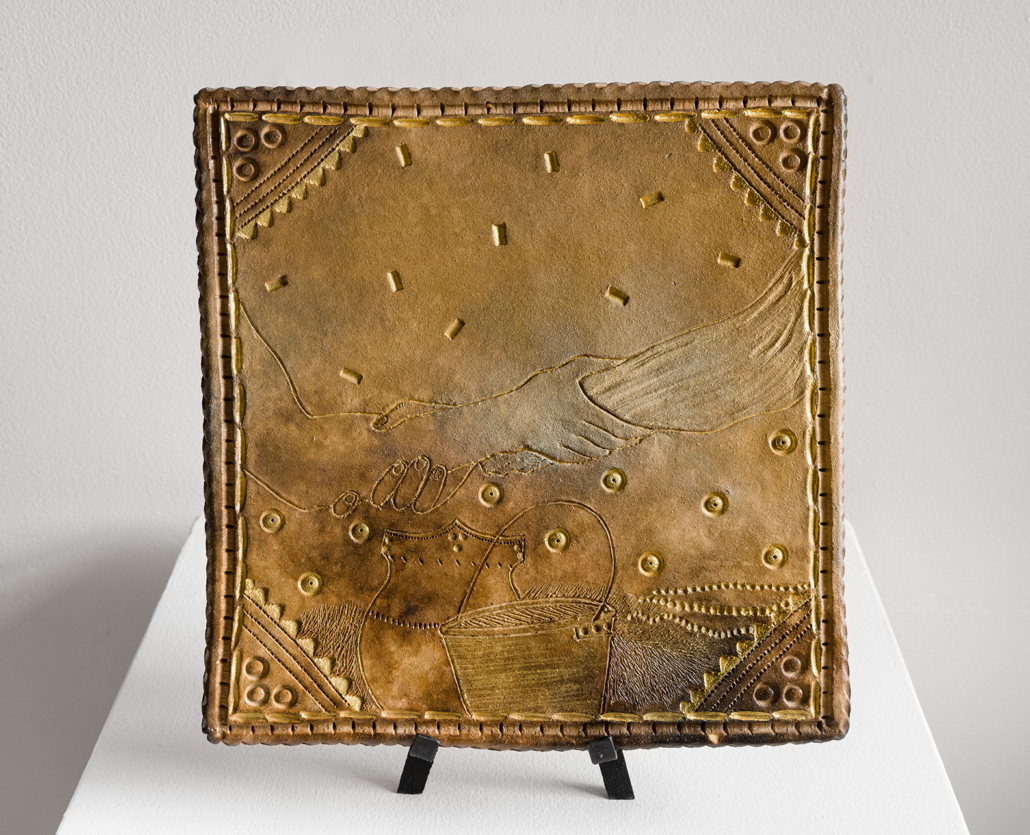NATASHA SMOKE SANTIAGO

The Trade (2021)
Clay, acrylic paint, oil-based varnish, kiln-fired with smoke, 12” x 12″
This original ceramic tile created for the Old Stone House was inspired by the 18th-Century beaver pelt and brass kettle trade between my Haudenosaunee/Mohawk ancestors and the colonial Dutch, French and English. It is documented that we would trade 4 beaver pelts per one brass kettle. I included images of a kettle and a clay pot next to each other, plus beaver pelts underneath. Before European contact the Haudenosaunee dug raw clay from the ground and shaped it into cooking pots. They retired clay pots around the early 1700s in favor of the Europeans’ non-breakable brass kettles. This artwork represents a time when the Haudenosaunee still used both clay pots and brass kettles. The patterns on the corners are based on Haudenosaunee effigies found on older clay pots. The arm grasp image depicts how traders used to greet each other. I included two types of beads–round (glass beads) and rectangular (wampum, made from shells and used as a form of currency). The Lenape (and others) on Long Island made wampum and traded it with the Haudenosaunee for centuries. Once the Europeans came, they often bought wampum from the Lenape and then exchanged it along with their own goods to the Haudenosaunee for beaver pelts.
In recent years Haudenosaunee artists were able to rediscover the lost art of Haudenosaunee clay pot-making (using hand-rolled coils instead of a potter’s wheel), and my work helps carry on this tradition. The tile is smoked in a similar way to how traditional pots were smoked, to produce a similar color variation. It is kiln-fired and then wood-smoked with pine and cedar to create the appearance of being pit-fired. The Trade alludes to both the historical influence of trade and the importance of cultural preservation today.
ABOUT THE ARTIST
Natasha Smoke Santiago was born in Rochester, New York and brought up in Haudenosaunee tradition. Her grandparents were part of a Mohawk diaspora in the mid 20th century who moved to cities like Syracuse, Rochester, Buffalo and NYC following the steel trade. She works in many mediums, chronicling traditional Haudenosaunee culture, contemporary life, the miracle of pregnancy and the beauty of the natural world. Natasha is one of a handful of artists, historians and living history enthusiasts attempting to resurrect and further elevate the Iroquoian style of pottery. The Tradition of the Longhouse and living one’s culture, by one’s cultural values, daily, without permission, is a central theme in her being. In the words of an Onondaga Leader: “To be sovereign, one must live sovereign.” In this tradition Natasha attempts to live sustainably on a small piece of disputed farmland, in a land claim area adjacent to Akwesasne. In addition to art, she also practices Indigenous seed keeping, gardening and occasional farming.
Follow her on Instagram at @storytellershouse.
